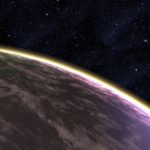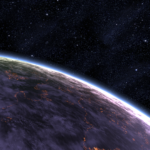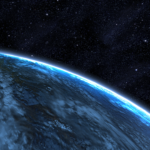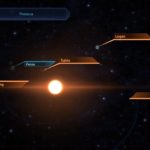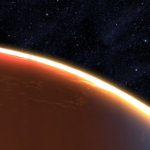System Specs:
- Stellar Mass: N/A Sol Masses
- Stellar Class: N/A
- Luminosity: N/A Sol
- Planets: 5
- Moons: 0
- Asteroid Belts: 0
- Asteroids: 0
- Objects: 0

Prerequisite: Priority: Tuchanka (Mass Effect 3)
Theseus is a former Prothean system. Three of its five worlds bear evidence of Prothean development. In modern times, ExoGeni Corporation has staked a claim on the ruins of Feros while the others are bereft of anything valuable, cost-ineffective for meaningful resource exploitation, or not thoroughly explored.
–
Planets Directory:
- Sytau
- Feros
- Sharring
- Quana
- Logan
–
Sytau:

- Orbital Distance: 1.05 AU
- Orbital Period: 1.1 Earth-years
- Keplerian Ratio: 0.957
- Radius: 9,547 km
- Day Length: 32.2 Earth-hours
- Atmospheric Pressure: 94.51 atm
- Surface Temp: 343 °C
- Surface Gravity: 1.7 g
- Mass: 3.781 Earth-masses
Sytau is shrouded by a high-pressure atmosphere composed of carbon dioxide and sulphuric acids. The surface is composed of geologically young plains of volcanic basalts and rhyolites, with high concentrations of carbon and radioactives.
Sytau is rabidly volcanic; a dozen “super-volcanoes” 50-120 kilometers wide are erupting across the planet. Sytau’s carbon content and constant volcanism make natural diamonds plentiful, if extremely costly and dangerous to recover.
–
Feros:
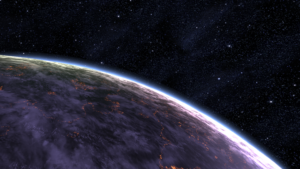
- Orbital Distance: 2.15 AU
- Orbital Period: 3.2 Earth-years
- Keplerian Ratio: 0.971
- Radius: 8,366 km
- Day Length: 30.3 Earth-hours
- Atmospheric Pressure: 5.44 atm
- Surface Temp: 10 °C
- Surface Gravity: 1.1 g
- Mass: 1.879 Earth-masses
- Satellites: Orcan, Vardet
- Colony: human
Capital: ExoGeni Building, founded 2178, population 300
The ExoGeni Corporation has founded a pilot colony on Feros to explore the Prothean ruins that blanket two-thirds of the planet’s land mass. The atmosphere is fouled with dust. Terrestrial travel is hampered by crumbled debris dozens of meters deep. There are indications that Feros was a much colder world in the past. Feros has two large moons, Orcan (the farther) and Vardet.
Codex Entry
Gnome-mime-sound-openclipart.png Audio: Feros
Feros is a habitable world in the Attican Beta cluster. Two-thirds of the habitable surface is covered with the ruins of a crumbling Prothean megatropolis. In the millennia since the Prothean extinction, the ruins have been picked over by looters many times.
Feros was considered a poor prospect for colonization, as little open ground remains for agriculture. The only sizable fresh water sources are the poles, which are tapped by the decaying Prothean aqueduct systems. The dead cities, while in good condition considering their antiquity, are of uncertain stability. Ground level is congested by a dozen meters of fallen debris, and the air is fouled by dust.
In 2178, the human ExoGeni Corporation announced its intention to place a permanent colony on Feros, to thoroughly explore the ruins. The pioneer settlement was placed on the upper levels of several intact skyscrapers, using the surviving Prothean aqueducts and rooftop hydroponic gardens to support the population.
–
Sharring:
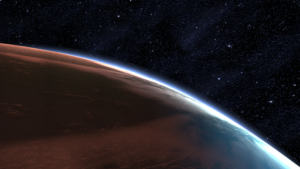
- Orbital Distance: 12.93 AU
- Orbital Period: 46.6 Earth-years
- Keplerian Ratio: 0.995
- Radius: 55,721 km
- Day Length: 14.6 Earth-hours
- Atmospheric Pressure: N/A atm
- Surface Temp: N/A °C
- Surface Gravity: N/A g
- Mass: N/A Earth-masses
- Satellites: > 60
Sharring is a standard hydrogen-helium gas giant. The atmosphere contains traces of ammonia, methane, and surprisingly large amounts of water vapor, making the atmosphere a striking mix of browns, blues, and whites. Of Sharring’s 60-odd moons, two have diameters of over 3,000 kilometers. Both have signs of former Prothean development, suggesting Sharring may have been mined for helium-3.
“The planet Sharring displayed some strange readings while being scanned. Chief Engineer Adams pinpointed the source and located a strange object. Tali and Adams brought it on board and spent hours taking it apart. The purpose of the object is still uncertain, but it was Prothean in nature and contained a Prothean data disc.”
–
Quana:

- Orbital Distance: 4.33 AU
- Orbital Period: 9.0 Earth-years
- Keplerian Ratio: 1.002
- Radius: 7,271 km
- Day Length: 67.8 Earth-hours
- Atmospheric Pressure: 0.91 atm
- Surface Temp: −141 °C
- Surface Gravity: 1.2 g
- Mass: 1.548 Earth-masses
Quana’s frozen surface is rich with heavy metals, and the planet’s higher than average density suggests further mineral richness in the depths. The atmosphere is composed of nitrogen and carbon monoxide.
The remains of a well-developed Prothean mining infrastructure dot the planet. Abandoned mines are connected to dead cities by collapsed maglev lines. Unlike the crumbling skyscrapers of Feros, Quana’s ruins are reasonably intact. Unfortunately, this only made it easier for looters to strip the silent necropoli of anything valuable.
–
Logan:

- Orbital Distance: 23.27 AU
- Orbital Period: 112.6 Earth-years
- Keplerian Ratio: 0.994
- Radius: 66,341 km
- Day Length: 18.6 Earth-hours
- Atmospheric Pressure: N/A atm
- Surface Temp: N/A °C
- Surface Gravity: N/A g
- Mass: N/A Earth-masses
Logan is a standard hydrogen-helium gas giant. The survey team who charted the system twenty years ago reported many strange disturbances in Logan’s cloud bands, suggesting many remarkably large solid objects were present beneath the cloud tops. As the ship approached, however, they subsided one by one. These disturbances have not been reported again.
–
–
video

